
EURASIP Journal on Applied Signal Processing 2005:8, 1205–1211
c
2005 Hindawi Publishing Corporation
A Multivariate Thresholding Technique for Image
Denoising Using Multiwavelets
Erdem Bala
Department of Electrical and Computer Engineering, University of Delaware, Newark, DE 19716, USA
Email: erdem@udel.edu
Ays¸in Ert¨
uz ¨
un
Electrical and Electronics Engineering Department, Bo˘
gazic¸i University, 34342 Bebek, Istanbul, Turkey
Email: ertuz@boun.edu.tr
Received 20 January 2004; Revised 21 November 2004; Recommended for Publication by Kiyoharu Aizawa
Multiwavelets, wavelets with several scaling functions, offer simultaneous orthogonality, symmetry, and short support, which is
not possible with ordinary (scalar) wavelets. These properties make multiwavelets promising for signal processing applications,
such as image denoising. The common approach for image denoising is to get the multiwavelet decomposition of a noisy image
and apply a common threshold to each coefficient separately. This approach does not generally give sufficient performance. In this
paper, we propose a multivariate thresholding technique for image denoising with multiwavelets. The proposed technique is based
on the idea of restoring the spatial dependence of the pixels of the noisy image that has undergone a multiwavelet decomposition.
Coefficients with high correlation are regarded as elements of a vector and are subject to a common thresholding operation.
Simulations with several multiwavelets illustrate that the proposed technique results in a better performance.
Keywords and phrases: multiwavelets, image denoising, multivariate thresholding.
1. INTRODUCTION
Multiwavelets are a relatively new addition to the wavelet the-
ory, and have received considerable attention since their in-
troduction [1,2,3,4,5,6,7,8,9,10,11,12,13,14]. Con-
trary to ordinary wavelets, multiwavelets offer simultaneous
orthogonality, symmetry, and short support. Similar to per-
forming wavelet decomposition with filters, multiwavelet de-
composition can be realized with filterbanks. The filter coef-
ficients in this case are, however, matrices instead of scalars.
Therefore, two or more input streams to the multiwavelet fil-
terbank are required to perform the decomposition. Several
methods have been developed for obtaining multiple input
streams from a given single input stream [2,3,4,15,16,17].
One of the widely used applications of wavelet decompo-
sition is the removal of additive white Gaussian noise from
noisy signals [18,19]. The discrimination between the actual
signal and noise is achieved by choosing an orthogonal basis,
which efficiently approximates the signal with few nonzero
coefficients. A signal enhancement can then be obtained
by discarding components below a predetermined threshold
value. Although the performance of multiwavelets has been
evaluated for image compression and coding (see, e.g., [20]
and the references therein), less work about denoising ap-
plications of multiwavelets exists [21,22,23]. Most of the
existing work concentrates on denoising of one-dimensional
signals. A detailed discussion of multiwavelets and their ap-
plications to signal and image processing can be found in
[5,24]. In these works, the noisy image is firstly decom-
posed with Geronimo, Hardin, and Massopust (GHM) [6]
multiwavelets, then each individual coefficient is thresholded
with the universal threshold [18]. This is similar to the ap-
proach that is widely used for image denoising with scalar
wavelet decomposition. The universal threshold is calculated
as λ=2σ2log nfor a length-nsignal that is corrupted
with additive white Gaussian noise with zero mean and vari-
ance σ2. This thresholding technique assumes that the noise
on each coefficient is independent. However, this assump-
tion may not be always valid for the coefficients of a multi-
wavelet decomposition. Therefore, a multivariate threshold-
ing scheme for one-dimensional signals using multiwavelets
was introduced in [17]. Instead of thresholding individual
multiwavelet coefficients, coefficient vectors are considered
and thresholding operation is applied to the whole vector.
In this paper, we design a multivariate thresholding tech-
nique designed specifically for image denoising. Simulations
with various multiwavelets and preprocessing methods re-
veal that the new technique performs better than term-by-
term thresholding, or the univariate method of [5].

1206 EURASIP Journal on Applied Signal Processing
H
G
↓2
↓2
H
G
↓2
↓2
Figure 1: Implementation of multiwavelet decomposition with fil-
terbanks.
This paper is organized as follows. In Section 2, the
multiwavelet theory is reviewed and some information on
the implementation of multiwavelet decomposition with fil-
terbanks is given. In Section 3, the proposed multivariate
thresholding technique for image denoising is introduced.
In Section 4, simulation results are presented and finally in
Section 5 conclusions are drawn.
2. BACKGROUND
Multiwavelets are characterized with several scaling func-
tions and associated wavelet functions. Let the scal-
ing functions be denoted in vector form as Φ(t)=
[φ1(t), φ2(t), ...,φL(t)]T,whereΦ(t) is called the multiscal-
ing function, Tdenotes the vector transpose and φj(t) is the
jth scaling function. Likewise, let the wavelets be denoted
as Ψ(t)=[ψ1(t), ψ2(t), ...,ψL(t)]T,whereψj(t) is the jth
wavelet function. Then, the dilation and wavelet equations
for multiwavelets take the following forms, respectively:
Φ(t)=
k
H[k]Φ(2t−k),
Ψ(t)=
k
G[k]Φ(2t−k).(1)
The lowpass filter Hand the highpass filter Gare L×Lma-
trix filters, instead of scalars. In theory, Lcouldbeaslargeas
possible, but in practice it is usually chosen to be two. Mal-
lat’s pyramid algorithm [25] for single scaling and wavelet
functions extends to the matrix version. The resulting two-
channel, 2 ×2 matrix filterbank operates on two input data
streams, filtering them into four output streams. Each of
these streams is then downsampled by a factor of two. This
procedureisillustratedinFigure 1.
Because a given signal consists of a single stream but the
filterbank needs two streams, a method of mapping the data
into two streams has to be developed. This mapping pro-
cess is called preprocessing and is performed by a prefilter
[5,7,16]. The postfilter, on the other hand, maps the data
from multiple streams into one stream again. In the design of
prefilters, it is desirable that properties of multiwavelet bases
such as orthogonality, approximation order, short support,
and symmetry are preserved as far as possible. For this rea-
son, research is going on for designing multiwavelet bases,
called balanced multiwavelets, for which prefiltering can be
avoided [26]. The type of the prefilter used in a specific ap-
plication is important for the performance. Our simulations
have revealed that the best image denoising results are ob-
tained with the repeated row prefilter and the approximation
prefilter [5].
3. THRESHOLDING WAVELET AND
MULTIWAVELET COEFFICIENTS
Significant wavelet coefficients are extracted by threshold-
ing as proposed by Donoho and Johnstone [18]. The two
mostly used methods of thresholding are soft threshold-
ing and hard thresholding. In hard thresholding, the co-
efficients below a threshold are set to zero; those which
are above the threshold remain untouched. In soft thresh-
olding, the coefficients below a threshold value are set to
zero as well, but coefficients above the threshold value are
shrunk. The amount of shrinking is equal to the threshold
value.
The universal threshold is applied to each individual
multiwavelet coefficient separately in [5]. However, the indi-
vidual multiwavelet coefficients are not independent because
using any prefilter other than the identity prefilter produces
correlated coefficients. Taking this fact into account, Downie
and Silverman [17] have proposed a multivariate thresh-
olding method for one-dimensional signal denoising. When
multiwavelet decomposition is applied to a one-dimensional
signal after prefiltering, each resultant coefficient is repre-
sented by a length-Lvector. Assuming L=2, the coefficient
is zj,k=z0
j,kz1
j,kT,where jdenotes the decomposition level,
kis the coefficient index, and Tis the vector transpose. The
thresholding operation is applied to the whole vector coeffi-
cients. Using the same approach, we have developed a mul-
tivariate thresholding method for multiwavelets that is ap-
plicable to image denoising. Due to the special properties
of two-dimensional multiwavelet decomposition, however, a
different approach should be followed. This idea is going to
be elaborated in the subsequent paragraphs.
During a single level of decomposition of an image using
a scalar wavelet, the two-dimensional data is replaced with
four blocks. These blocks correspond to the subbands that
represent either lowpass filtering or highpass filtering in each
direction. The procedure for wavelet decomposition consists
ofconsecutiveoperationsonrowsandcolumnsofthetwo-
dimensional data. The wavelet transform first performs one
step of the transform on all rows. This process yields a ma-
trix where the left side contains downsampled lowpass coef-
ficients of each row, and the right side contains the highpass
coefficients. Next, one step of decomposition is applied to all
columns; this results in four types of coefficients.
(1) HH represents the diagonal features of the image and
is formed by highpass filtering in both directions.
(2) HL represents the horizontal features of the image and
is formed by lowpass filtering the rows and then high-
pass filtering the columns.
(3) LH represents the vertical features of the image and is
formed by highpass filtering the rows and then lowpass
filtering the columns.
(4) LL represents the coefficients that will be further de-
composed in the next step. It is formed by lowpass fil-
tering both the rows and the columns.
The subbands corresponding to a single-level scalar wavelet
decomposition are illustrated in Figure 2.

Image Denoising Using Multiwavelets 1207
LL
HL
LH
HH
Figure 2: Subbands corresponding to a single-level wavelet decom-
position.
L1L1
L2L1
H1L1
H2L1
L1L2
L2L2
H1L2
H2L2
L1H1
L2H1
H1H1
H2H1
L1H2
L2H2
H1H2
H2H2
Figure 3: Subbands corresponding to a single-level multiwavelet
decomposition.
The multiwavelet decomposition is similar to the wavelet
decomposition, but has some differences. The multiwavelet
filterbanks have two channels, so the decomposition will have
two sets of scaling coefficients and two sets of wavelet coeffi-
cients. For multiwavelets, the Land Hlabels have subscripts
denoting the channel to which the data corresponds. For ex-
ample, the subband L1H2represents the data from the second
channel highpass filtered in the horizontal direction, and the
first channel lowpass filtered in the vertical direction.
It has been shown that there exists a spatial dependence
between pixels in the different subbands of a wavelet decom-
position [27]. This dependence is in the form of a parent-
child relationship. Each parent pixel in a deeper decompo-
sition level has four children in the upper level in the form
ofa2×2 block of adjacent pixels. This idea has been ex-
tensively used in image coding because the statistics of the
parent-child pixels are similar. If the parent coefficient has a
small value, then the children would likely have small values.
If the parent coefficient has a large value, the children might
also have large values. This observation can also be used for
a multivariate image denoising scheme for multiwavelets. If
coefficients with high correlations are handled together and
thresholding operation is applied to them simultaneously, we
may expect to get better results. However, the parent-child
relationship does not hold for multiwavelet decomposition
[20]. This is due to the fact that, in a single-level decomposi-
tion, each of the three subbands LH,HL,andHH are further
split into four smaller subbands. This operation destroys the
parent-child relationship. The output structure of an image
after a single-level multiwavelet decomposition is illustrated
in Figure 3. Observations reveal that there is a large amount
of similarity in each of the subbands. This suggests that the
spatial dependence of the pixels could be restored. As an ex-
ample, the Lena image after being exposed to a single-level
50
100
150
200
250
50 100 150 200 250
Index
Pixel
(a)
20
40
60
80
100
120
20 40 60 80 100 120
Index
Pixel
(b)
Figure 4: The single-level multiwavelet decomposition of the Lena
image: (a) the whole image; (b) the HH subband of the image.
multiwavelet decomposition is illustrated in Figure 4a and
the HH subband of the same image consisting of four smaller
subbands is illustrated in Figure 4b. The similarity between
the illustrated subbands is observable from the figure.
For image denoising applications, the spatial dependence
of the pixels should be restored so that coefficients with high
correlation can undergo a common thresholding operation.
The same observation has been used for designing a novel
quantization scheme for image compression in [20]. To illus-
trate this point more clearly, the HH subband of Figure 3 is
shown in Figure 5. The coefficients represented with dots in
Figure 5 would have been placed next to each other if scalar
wavelet decomposition had been applied. This observation
suggests that vectors of length four can be formed by using
acoefficient from each of the four subbands. These coeffi-
cients are chosen such that they have the same location in
their respective subbands. For example, the four coefficients
shown in Figure 5 would form a vector. Then, a multivari-
ate thresholding operation is applied to each of these vectors.
This procedure is repeated separately for all of the coefficients
in all three subbands HH,HL,andLH.

1208 EURASIP Journal on Applied Signal Processing
H1H2
H2H2
H1H1
H2H1
Figure 5: HH subband corresponding to a single-level multiwavelet
decomposition.
Applying the multiwavelet transform with a prefilter to a
noisy image, and then collecting the coefficients in each sub-
band in vectors of length four, we get vector coefficients of
the form [2]
wj,k=υj,k+ρj,k,(2)
where υis the noise-free multiwavelet coefficient vector, ρis
the multiwavelet coefficient vector of the noise, wrepresents
the multiwavelet coefficient vector of the corrupted signal, j
is the decomposition level, and kis the coefficient index. ρj,k
has a multivariate normal distribution N(0,Θj). Θjis the co-
variance matrix for the noise term and depends on the reso-
lution level j. We would like to whiten the noise so that each
coefficient within the vector would be distributed indepen-
dently. We assume that there is no signal component in the
vector. Then, the whitening operation could be achieved by
multiplying the noise vector with Θ−1/2
j.Ifyj,k=Θ−1/2
jwj,k,
then it can be easily shown that the covariance matrix of yis
the identity matrix. The squared length of the vector ycan be
computed by
σj,k=yT
j,kyj,k=wT
j,kΘ−1
jwj,k,(3)
where the superscript Tdenotes the transpose. σj,kis a posi-
tive scalar value and has a Chi-squared distribution with four
degrees of freedom. The analogous hard thresholding and
soft thresholding rules can be applied as in (4)and(5), re-
spectively:
ˆ
wj,k=wj,k·1σj,k≥λ,(4)
ˆ
wj,k=wj,k·max σj,k−λ,0
σj,k
.(5)
Similar to the procedure developed in [17], this threshold-
ing technique treats the highly correlated multiwavelet co-
efficients simultaneously and applies a common threshold to
the vector of coefficients. The effect of correlation is compen-
sated by a whitening transformation. The covariance matrix
used for the transformation depends on the decomposition
level and is calculated for the HH,HL,andLH subbands sep-
arately at each decomposition level. We also have to calculate
the threshold value λ. We assume that there are Nidentically
and independently distributed χ2
4random variables and the
Table 1: SNRs of the denoised image which is preprocessed with
approximation prefiltering.
Multiwavelet
type
Univariate
thresholding
Proposed
method
GHM 10.8470 12.3092
CL 7.2023 12.5086
SA4 10.4630 12.6768
Table 2: SNRs of the denoised image which is preprocessed with
repeated row prefiltering.
Multiwavelet
type
Univariate
thresholding
Proposed
method
GHM 10.9016 13.0763
CL 9.8595 13.2839
SA4 10.1522 12.9515
maximum of these random variables is denoted by M.The
threshold value λis the infimum of all sequences λNsuch
that
PM≤λN−→ 1asN−→ ∞ .(6)
As the number of pixels go to infinity, the probabil-
ity of the threshold being greater than the maximum of
the noise random variables approaches to one. This guar-
antees that, with high probability, a signal component ex-
ists in coefficients that are larger than the threshold value.
The threshold value can be found by using the cdf of Min
the limit problem (6) and solving for λ. An appropriate se-
quence satisfying the relation in (6) has been shown to be
λN=2logN+2loglogN[28]. Therefore, this is the value
that is used for thresholding the multiwavelet coefficient vec-
tors.
4. SIMULATION RESULTS
The performance of the multivariate multiwavelet threshold-
ing method that has been proposed in this paper is investi-
gated with simulations. White Gaussian noise with σ=25 is
added to a 256×256 Lena image and denoising by soft thresh-
olding with the proposed method is carried out with GHM
[5], CL [8], and SA4[29] multiwavelets. The same image and
multiwavelets are then used for denoising with the univariate
scheme. The performance of the scalar wavelet D4[30] is also
studied under the same conditions. The prefiltering methods
used for the multiwavelet decompositions are the approxi-
mation prefiltering [5] and the repeated row prefiltering [5].
The simulation results can be evaluated objectively and
subjectively. For objective evaluation, the signal to noise ra-
tio (SNR) of each denoised image has been calculated. The
SNR of the noisy Lena image before exposed to any denois-
ing operation is 6.3793 dB. The SNR values of the denoised
images are listed in Tables 1and 2.TheSNRs of the denoised
images which are preprocessed with approximation prefilter-
ing and repeated row prefiltering are given in Tables 1and 2,

Image Denoising Using Multiwavelets 1209
(a)
(b)
Figure 6: Denoised Lena image by approximation prefiltering: (a)
decomposed with the GHM multiwavelet and thresholded with the
univariate scheme; (b) decomposed with the SA4 multiwavelet and
thresholded with the proposed scheme.
respectively. Figures 6to 8illustrate some of the denoised im-
ages for subjective performance comparison. Some impor-
tant observations can be made from the simulation results.
The objective and subjective results prove that the proposed
multivariate image denoising technique performs better than
the univariate denoising method. The SNR values of the de-
noised images with the proposed technique are higher and
the quality of the images is superior. The highest SNR of
12.6768 dB with approximation prefiltering is attained with
the SA4 multiwavelet and the proposed technique. Similarly,
the highest SNR of 13.2839 dB with repeated row prefilter-
ing is attained with the CL multiwavelet and the proposed
technique. In general, results for the repeated row prefiltering
method seem to be better for both multivariate and univari-
ate thresholding methods. It is also observed that the mul-
tiwavelets produce more satisfactory results than the ordi-
nary scalar wavelets. The SNR of the denoised image with
the scalar D4 wavelet is 10.0017 dB.
(a)
(b)
Figure 7: Denoised Lena image by repeated row prefiltering: (a)
decomposed with the GHM multiwavelet and thresholded with the
univariate scheme; (b) decomposed with the CL multiwavelet and
thresholded with the proposed scheme.
Figure 8: Denoised Lena image decomposed with the D4 scalar
wavelet and thresholded with the univariate scheme.

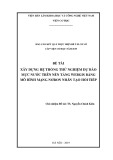
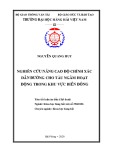
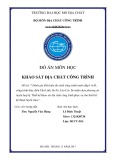
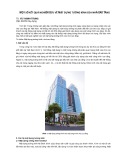
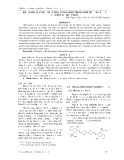
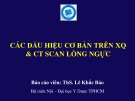
![Thuyết minh tính toán kết cấu đồ án Bê tông cốt thép 1: [Mô tả/Hướng dẫn/Chi tiết]](https://cdn.tailieu.vn/images/document/thumbnail/2016/20160531/quoccuong1992/135x160/1628195322.jpg)

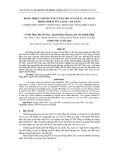
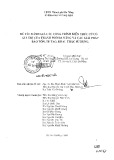








![Báo cáo seminar chuyên ngành Công nghệ hóa học và thực phẩm [Mới nhất]](https://cdn.tailieu.vn/images/document/thumbnail/2025/20250711/hienkelvinzoi@gmail.com/135x160/47051752458701.jpg)






